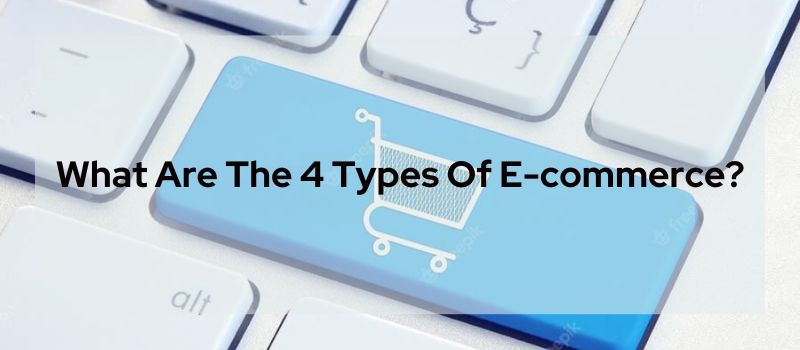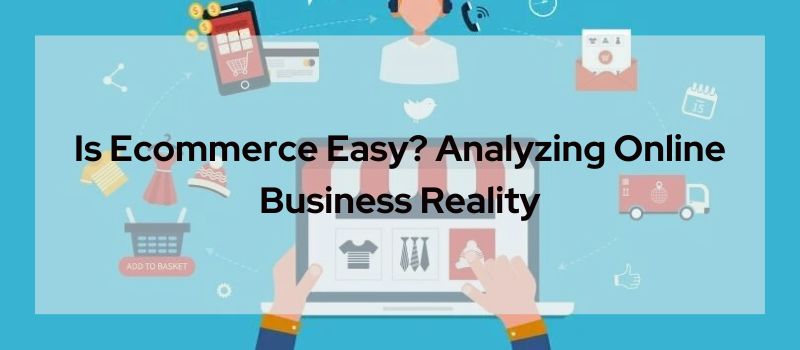E-commerce has transformed contemporary retail and business. E-commerce includes everything from placing orders for products and technology to managing enterprises online. Did you aware that there are various types of online businesses? what are the 4 types of E-Commerce that will be covered in this blog? and the traits they possess.
E-commerce has four main categories: B2C, B2B, C2C, and C2B. B2C transactions include online shopping on Amazon and eBay. B2B transactions, such as wholesalers selling to retailers, are business-to-business. C2C markets, including classified ad websites, let clients transact directly. Finally, C2B involves customers selling goods or services to businesses through freelance platforms or influencer relationships.
After describing the four e-commerce categories, you may be asking how they work and what makes them different. How do these categories affect online buying, selling, and connecting? This essay will examine each category using real-world examples and discuss their benefits and drawbacks. This article will help you understand e-commerce, whether you’re a budding entrepreneur or a curious customer.
These four e-commerce types are just the beginning. Technological advances and the ever-changing digital world create new e-commerce models. Organizations and customers must understand e-commerce to navigate the digital world. Join us as we explore the interesting complexity of e-commerce and its potential for global trade.

Contents
- 1 Definition Of E-commerce
- 2 What Are The 4 Types Of E-commerce?
- 3 Examples of Each Type
- 4 Comparison of the Types
- 5 Importance and Benefits of E-commerce
- 6 FAQs
- 6.1 What is the main difference between B2C and B2B e-commerce?
- 6.2 Can an individual start a B2B e-commerce business?
- 6.3 Is C2C e-commerce limited to second-hand goods only?
- 6.4 How does C2B e-commerce impact traditional employment models?
- 6.5 What are the key advantages of e-commerce for small businesses?
- 7 Conclusion
Definition Of E-commerce
The term “e-commerce,” which stands for “electronic commerce,” describes the practice of carrying out business dealings electronically over the Internet. Through numerous internet platforms, it entails the buying and selling of products, services, or information. The old brick-and-mortar retail paradigm has been transformed by e-commerce because it allows customers and businesses to interact and transact without interruption across geographic borders.
What Are The 4 Types Of E-commerce?
Business-to-Business (B2B), Business-to-Consumer (B2C), Consumer-to-Consumer (C2C), and Consumer-to-Business (C2B) are the four main categories of e-commerce that shape the digital marketplace. B2B refers to business-to-business interactions, whereas B2C refers to firms selling goods directly to customers.
While C2B enables business-to-business transactions between customers, C2C enables peer-to-peer transactions between consumers. These four types give a thorough review of the various ways in which online commerce is successful. Learn more about each category and investigate the exciting potential of e-commerce.
Business-to-Consumer (B2C)
Definition: B2C e-commerce involves transactions between businesses and individual consumers.
Characteristics: It is the most common type of e-commerce, where businesses sell products or services directly to consumers.
Examples: Online retail stores like Amazon, clothing brands with online shopping platforms, and food delivery services.
Business-to-Business (B2B)
Definition: B2B e-commerce focuses on transactions between businesses rather than consumers.
Characteristics: It involves the exchange of goods, services, or information between different businesses.
Examples: Wholesale suppliers selling products to retailers, software companies providing solutions to enterprises, and manufacturers sourcing raw materials from suppliers.
Consumer-to-Consumer (C2C)
Definition: C2C e-commerce facilitates transactions between individual consumers.
Characteristics: It enables individuals to sell products or services directly to other consumers through online platforms.
Examples: Online classified websites, peer-to-peer marketplace platforms, and second-hand goods marketplaces.
Consumer-to-Business (C2B)
Definition: C2B e-commerce reverses the traditional consumer-business relationship.
Characteristics: Individuals offer products, services, or information to businesses in this model.
Examples: Freelance platforms, where individuals offer their skills and services to businesses, user-generated content platforms, and influencer marketing.

Examples of Each Type
B2C Examples
Amazon: The largest online retailer offering a wide range of products to individual consumers.
Zappos: An online shoe and clothing store catering to individual shoppers.
Uber Eats: A food delivery service connecting restaurants with individual consumers.
B2B Examples
Alibaba: A global wholesale marketplace connecting businesses to source products.
SAP: A software company providing enterprise solutions to businesses.
UPS: A logistics company offering shipping and supply chain services to other businesses.
C2C Examples
eBay: An online auction and shopping platform enabling individuals to sell products to other consumers.
Airbnb: A platform allowing individuals to rent accommodations to fellow travelers.
Poshmark: An online marketplace for buying and selling second-hand fashion items.
C2B Examples
Upwork: A platform where freelancers offer their services to businesses.
YouTube: A video-sharing platform where individuals create content and monetize it through advertising.
Instagram influencers: Individuals partnering with businesses to promote products and services.

Comparison of the Types
Each type of e-commerce has its unique characteristics and target audience. B2C focuses on selling to individual consumers, while B2B caters to business needs. C2C enables individuals to directly engage in transactions, and C2B empowers individuals to offer their skills or content to businesses. Understanding these differences helps businesses choose the appropriate e-commerce model that aligns with their target market and objectives.
Importance and Benefits of E-commerce
E-commerce has become integral to the modern business landscape due to its numerous benefits. It offers convenience, accessibility, and a global reach for businesses. Consumers enjoy the convenience of shopping from anywhere, anytime, and gaining access to a wide range of products and services.
E-commerce reduces costs, streamlines operations, and opens up new market opportunities for businesses. It fosters competition, and innovation, and empowers individuals to participate actively in the digital economy.
FAQs
What is the main difference between B2C and B2B e-commerce?
The main difference between B2C (Business-to-Consumer) and B2B (Business-to-Business) e-commerce lies in their target audiences. B2C e-commerce involves businesses selling products or services directly to individual consumers. The transactions are typically smaller in scale, and the focus is on meeting the needs and preferences of individual customers.
On the other hand, B2B e-commerce involves businesses selling products or services to other businesses. The transactions in B2B e-commerce are usually larger in scale, and the focus is on meeting the specific requirements of businesses, such as bulk orders, negotiated contracts, and customized solutions.
Can an individual start a B2B e-commerce business?
Yes, an individual can start a B2B e-commerce business. While B2B e-commerce traditionally involves interactions between businesses, there are platforms and marketplaces available that allow individuals to start and operate B2B e-commerce businesses. These platforms provide opportunities for individuals to connect with suppliers, manufacturers, or wholesalers, and sell products or services to other businesses.
Is C2C e-commerce limited to second-hand goods only?
C2C (Consumer-to-Consumer) e-commerce is not limited to second-hand goods only. While C2C platforms often facilitate the buying and selling of used products between individuals, they can also support the sale of new products or services. Examples of C2C platforms include online classifieds, auction websites, and peer-to-peer sharing platforms.
How does C2B e-commerce impact traditional employment models?
C2B (Consumer-to-Business) e-commerce refers to situations where consumers offer products, services, or information to businesses. This model can impact traditional employment models by providing individuals with alternative opportunities for earning income.
C2B e-commerce allows individuals to become entrepreneurs, freelancers, or consultants, offering their expertise, creativity, or unique products directly to businesses. It can enable flexible work arrangements and challenge the traditional employer-employee relationship.
What are the key advantages of e-commerce for small businesses?
E-commerce offers several key advantages for small businesses:
Increased reach and access to a global market: E-commerce allows small businesses to overcome geographical limitations and reach customers beyond their local area, potentially expanding their customer base and sales opportunities.
Lower costs and overhead: Setting up an online store can be more cost-effective compared to establishing a physical storefront. E-commerce eliminates expenses associated with rent, utilities, and staff required for a brick-and-mortar store.
24/7 availability: Online stores can remain open and accessible to customers at all times, providing the convenience of shopping whenever it suits the customers, potentially leading to increased sales.
Targeted marketing and personalized customer experience:
E-commerce platforms often provide tools for targeted marketing and personalized customer interactions, allowing small businesses to tailor their offerings and promotions to specific customer segments.
Data-driven insights: E-commerce platforms offer analytics and data tracking tools that enable businesses to gather valuable customer insights, identify trends, and make informed decisions to improve their products, services, and marketing strategies.
Conclusion
As technology continues to advance, e-commerce continues to evolve, enabling businesses and consumers to connect and transact in unprecedented ways. Understanding the four types of e-commerce—B2C, B2B, C2C, and C2B—provides insights into the diverse opportunities available in the digital marketplace. By leveraging the right e-commerce model, businesses can unlock growth, reach new customers, and thrive in the digital era.
Click here to get free ecommerce expert consultation!
Read More:
Innovative Ideas to Launch Your Ecommerce Store Without Competitors | Made Online Selling Easy



